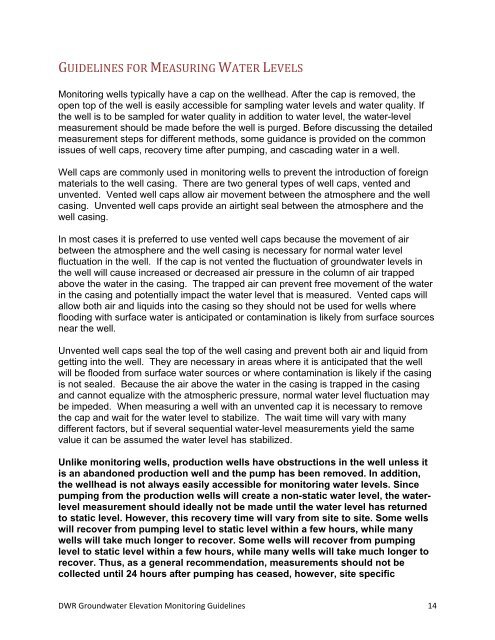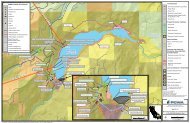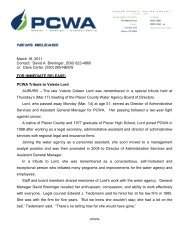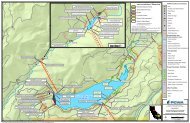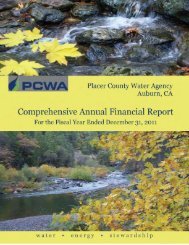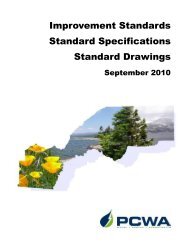Martis Valley Groundwater Management Plan - Placer County Water ...
Martis Valley Groundwater Management Plan - Placer County Water ...
Martis Valley Groundwater Management Plan - Placer County Water ...
You also want an ePaper? Increase the reach of your titles
YUMPU automatically turns print PDFs into web optimized ePapers that Google loves.
GUIDELINES FOR MEASURING WATER LEVELS<br />
Monitoring wells typically have a cap on the wellhead. After the cap is removed, the<br />
open top of the well is easily accessible for sampling water levels and water quality. If<br />
the well is to be sampled for water quality in addition to water level, the water-level<br />
measurement should be made before the well is purged. Before discussing the detailed<br />
measurement steps for different methods, some guidance is provided on the common<br />
issues of well caps, recovery time after pumping, and cascading water in a well.<br />
Well caps are commonly used in monitoring wells to prevent the introduction of foreign<br />
materials to the well casing. There are two general types of well caps, vented and<br />
unvented. Vented well caps allow air movement between the atmosphere and the well<br />
casing. Unvented well caps provide an airtight seal between the atmosphere and the<br />
well casing.<br />
In most cases it is preferred to use vented well caps because the movement of air<br />
between the atmosphere and the well casing is necessary for normal water level<br />
fluctuation in the well. If the cap is not vented the fluctuation of groundwater levels in<br />
the well will cause increased or decreased air pressure in the column of air trapped<br />
above the water in the casing. The trapped air can prevent free movement of the water<br />
in the casing and potentially impact the water level that is measured. Vented caps will<br />
allow both air and liquids into the casing so they should not be used for wells where<br />
flooding with surface water is anticipated or contamination is likely from surface sources<br />
near the well.<br />
Unvented well caps seal the top of the well casing and prevent both air and liquid from<br />
getting into the well. They are necessary in areas where it is anticipated that the well<br />
will be flooded from surface water sources or where contamination is likely if the casing<br />
is not sealed. Because the air above the water in the casing is trapped in the casing<br />
and cannot equalize with the atmospheric pressure, normal water level fluctuation may<br />
be impeded. When measuring a well with an unvented cap it is necessary to remove<br />
the cap and wait for the water level to stabilize. The wait time will vary with many<br />
different factors, but if several sequential water-level measurements yield the same<br />
value it can be assumed the water level has stabilized.<br />
Unlike monitoring wells, production wells have obstructions in the well unless it<br />
is an abandoned production well and the pump has been removed. In addition,<br />
the wellhead is not always easily accessible for monitoring water levels. Since<br />
pumping from the production wells will create a non-static water level, the waterlevel<br />
measurement should ideally not be made until the water level has returned<br />
to static level. However, this recovery time will vary from site to site. Some wells<br />
will recover from pumping level to static level within a few hours, while many<br />
wells will take much longer to recover. Some wells will recover from pumping<br />
level to static level within a few hours, while many wells will take much longer to<br />
recover. Thus, as a general recommendation, measurements should not be<br />
collected until 24 hours after pumping has ceased, however, site specific<br />
DWR <strong>Groundwater</strong> Elevation Monitoring Guidelines 14


